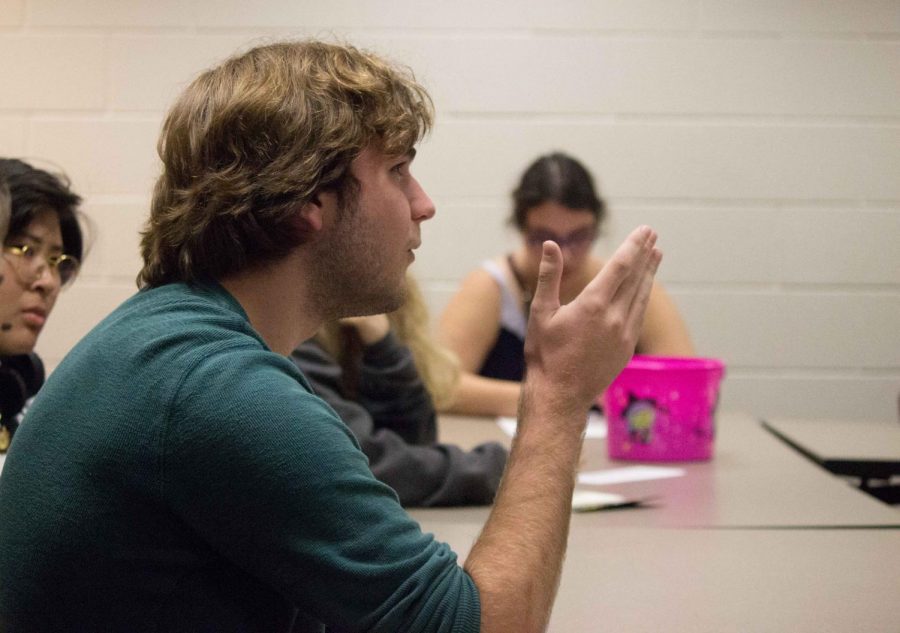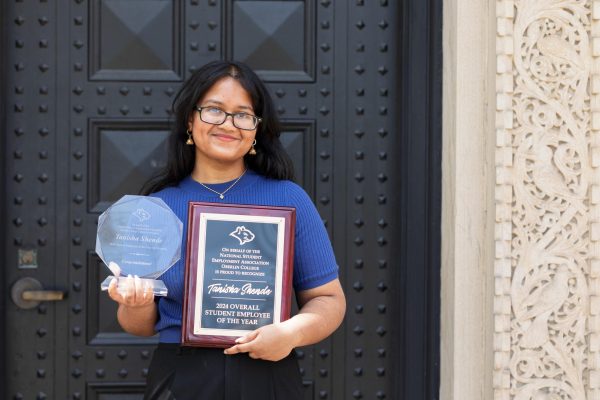Trustees Reject Proposal for Student Representative
College first-year Ben Diener talks at the Student-Trustee forum on Oct. 12. The Board of Trustees recently rejected the Student Trustee Task Force’s proposal to add a student trustee to the board.
Former Student Senate Liaison and fifth-year double-degree student Jeremy Poe submitted a letter to the Review 18 months ago calling for student representation on the Board of Trustees. After months of follow-up activism and mobilization from students and Oberlin community members, the board officially rejected a resolution proposing student representatives during their quarterly meetings Oct. 5–7.
The proposal requested that the board allow students to sit in on its meetings to improve transparency and communication between the board and student body.
The board’s Student Trustee Task Force — formed after March’s Trustee-Senate retreat to investigate the potential benefits of adding student representation — drafted the proposal. The task force was created due to outspoken student demand after a petition was submitted to the board with over 150 signatures and a protest outside the retreat.
The task force was composed of two students — Student Senate chair Thobeka Mnisi and Student Senator Josh Koller, both College seniors; and three board members — Jacob Gayle, OC ’79, Anne Chege, OC ’16, and Ed Helms, OC ’96. The Board of Trustees Chair Chris Cananvan, OC ’84, also attended some of the meetings.
Students received word of the rejection through an Oct. 9 Student Senate email after the weekend of board meetings.
“This is not the outcome we were hoping for and working towards for the last two years,” wrote Senate in an email. “We want to extend our heartfelt thanks to all of the students who came to the trustee fora on Thursday night.”
Canavan released a report Tuesday detailing the board’s discussions during the weekend, including their decision to reject the proposal.
“A healthy board is one on which every trustee feels absolutely comfortable thinking out loud,” Canavan wrote in the statement. “Trustees are no less human than students: when we think out loud, we take note of who’s in the room, consciously or subconsciously. Most trustees, including those who might otherwise support the resolution, worry that some of us would think out loud less candidly if students were in the room. As chair, that’s unacceptable to me.”
For some students who have worked for greater representation during their time at Oberlin, the rejection was a major blow.
“It more or less baffles me that these couple dozen highly-qualified adults who care so much about Oberlin — they’ve all worked in professions where they have had to deal with some uncomfortable situations, where they’ve had to navigate that — it seems are just so frightened by students that they don’t think they can speak their mind in front of students,” Koller said.
Koller emphasized the importance of student voices on campus, particularly in crucial decisions that affect the long-term viability of the College.
“I think [the stated reasoning] says something kind of scary about the board,” he said. “Students are not nearly the only important constituents of the school, but we are more or less the lifeblood of the College and Conservatory.”
Canavan said that although the board won’t be accepting a student representative, it is still actively discussing ways to better engage students.
“There will be an ongoing commitment to thinking about board governance and thinking about how the board works,” he said. “That should include thinking about how we engage with students. We view this as an evolution, and I don’t think anyone suggests that that evolution should stop where it is. We just need to find out what that next step looks like.”
President Carmen Ambar said that given this closed avenue, students should seek other channels to voice their thoughts within the current confines of representation.
“One of the things I would encourage students to do is to also think about the ways [they] can engage with the board and have [their] views heard,” Ambar said. “That may not result in student participation on the board in the way that students perceive it now. At the end of the day the board has made a decision. That doesn’t mean the board is not thinking about other options.”





